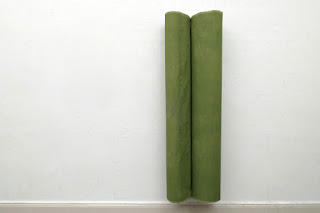| Die Washeit, 60x40x3cm (23.6x15.7x1.2"), paint on painting wooden board. I don't think anyone could tell by seeing this little thing how many days, layers of colors, hues and shades, among sandings and washings it took me to reach this ostensible mere turquoise surface, which photography cannot account for. I show it to you for what it's worth. Maybe it's not worth anything, i just did my best. So maybe my best isn't worth much after all. In the meantime, it continues to question me... The condition, 163x44x23cm (64x17x10"), acrylic on prepared inverted canvas. With the aim of ballasting and stabilizing the surface while preserving the thinness of the material, also hoping that during the second phase the rather liquid acrylic i use would not cause the thing to warp and crinkle too much, i applied on the back a coat of epoxy. Three days later, after a complete drying of the resin, as i was painting the front left to right and top to bottom in four approximate portions with a blend of primary yellow, Payne's gray, English red and turquoise blue, the canvas began to curl on itself from the top, then from bottom and as i didn't want to stretch or fix it, i let it do as it pleased and it closed itself completely in two parts. Then, unrolling it, i saw that the thing had warped and wrinkled and creased and twisted like an old parchment... in short precisely what i wished to avoid. But instead of angrily throwing the work away in the yard trash can with shouts of rage (no, just kidding, i throw the works away stilly, silently and methodically), i let time pass over and rolled it the other way, also in two parts. Last pic for a more decent light. Daylight. |

































































































































































